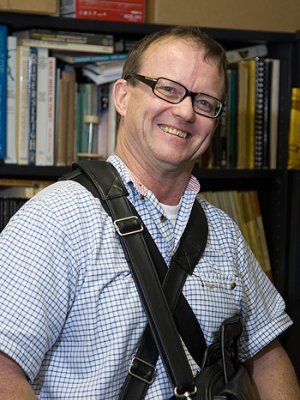
Living in primitive surrounds with no proper shower or bed for a month would have many people on the first flight back to Australia, but for UQ’s Professor Ian Lilley, the search for that pinnacle find is too overpowering to ignore.
For days on end, the archaeologist can be found confined to a small pit in some of the world’s most remote and undeveloped destinations.
“You’re living in very close and usually very public quarters with people and it can be extremely basic, no shower for a month, no toilet for a month, no proper bed for a month,” Professor Lilley said.
“My kids wonder why we don’t camp for leisure – you’ve got to be kidding!”
Most of the time, a single dirt airstrip is his only escape back to civilisation – a reassurance as his travels can sometimes take him through regional conflicts.
A graduate of UQ’s School of Social Sciences, who currently works in the Aboriginal and Torres Strait Islander Studies Unit at UQ, Professor Lilley has worked in archaeology and cultural heritage management in Australia and the surrounding region for nearly 30 years.
His most recent project saw him pack up his tool kit and set flight for Tiga Island, a rugged speck of raised coral in the South Pacific – commonly referred to by the Professor as a “lopsided wedding cake”.
This is the fifth year he has visited Tiga, first on pilot study jointly funded by the French and Australian Governments and since 2007 on an ARC Discovery project he directs.
One aspect of the work has been the discovery of a unique ancient water harvesting system, found deep within the island’s many caves.
“When whites first went there, there were probably 200 to 300 people living on this tiny island with no water,” Professor Lilley said.
“There is no surface water on Tiga Island…though you can occasionally find water leaking out of the bottom of the coral cliffs at low tide.”
Professor Lilley was captivated by the intelligence of the harvesting system, which in some caves included structures that resembled modern-day bathroom basins.
Along with the water systems, the team also discovered Lapita and other pottery, human remains and ash mounds from fire torches used by the caves’ previous occupants.
“Lapita pottery is highly distinctive and was used by the first humans to colonise the remote Pacific beyond the end of the main Solomon Islands. It is found from New Britain near New Guinea out to Samoa and Tonga,” Professor Lilley said.
“The earliest Lapita dates from 3300 years ago in New Britain to around 2900 years ago in Tonga, tracking the west-east movement of the colonisers.
“The human remains are being studied by specialists with the permission of the Tiga community. This work will reveal a great deal about diet, disease, social relationships and migration patterns.”
The thrill of helping piece together the history of ancient civilisations is the “elixir” that keeps the World Heritage Assessor searching.
“There’s always some little quirk…there’s always the unexpected, it usually always comes on the last day of the trip,” he said.
“The work I did in New Britain in the early 80s with the Australian Museum…it was the whole Indiana Jones trip, it was twenty people carrying big boxes on their heads walking through the jungle for days.
“We were taken off to a cave deep in the mountains…just as we were finishing up we found this very thin little layer and it turned out to be from the end of the last Ice Age.
“It was the first time anyone had found evidence that old beyond mainland New Guinea. There are lots of sites in the islands much older than that now, but at the time it was very impressive, especially to a 22 year-old.
“Not long afterwards I was part of a big international National Geographic project on Pacific colonisation. We hired a sailing boat from Dick Smith and went cruising through the islands.
“I was by far the most junior person involved as a team-leader. I took time out of my PhD…it was all pretty thrilling.”
Professor Lilley has recently reached several career milestones, including being elected a Fellow of the Society of Antiquaries of London, the UK’s second most ancient Royal scientific society, and Secretary General of the ICOMOS International Committee on Archaeological Heritage Management.
ICOMOS is the statutory advisory body to UNESCO on cultural heritage.
“I remember two of my very senior colleagues being elected as Fellows of the Society of Antiquaries when I was doing my PhD at ANU. It was really quite a big deal and it’s been in the back of my mind since then as something that you aspire to,” he said.
In late 2007, Professor Lilley was chosen by ICOMOS to assess Papua New Guinea’s first World Heritage nomination, at Kuk in the highlands near Mt Hagen.
“Kuk is a site of immense importance because it demonstrates that people in New Guinea independently invented agriculture at the same time as people in the Middle East,” he said.
“Although I worked in PNG for many years, I was last in Mt Hagen when I was about nine years-old, so it was a fascinating trip!”
Professor Lilley is currently working with his New Caledonian and French colleagues on two bilingual publications about Tiga, one in French and English, and the other in French and Maré, the language of Tiga.
He is also co-authoring a new book on Australian archaeology for Cambridge University Press.
Media: Professor Ian Lilley (3365 7051, i.lilley@uq.edu.au) or Eliza Plant at UQ Communications (07 3365 2619)
.jpg)

